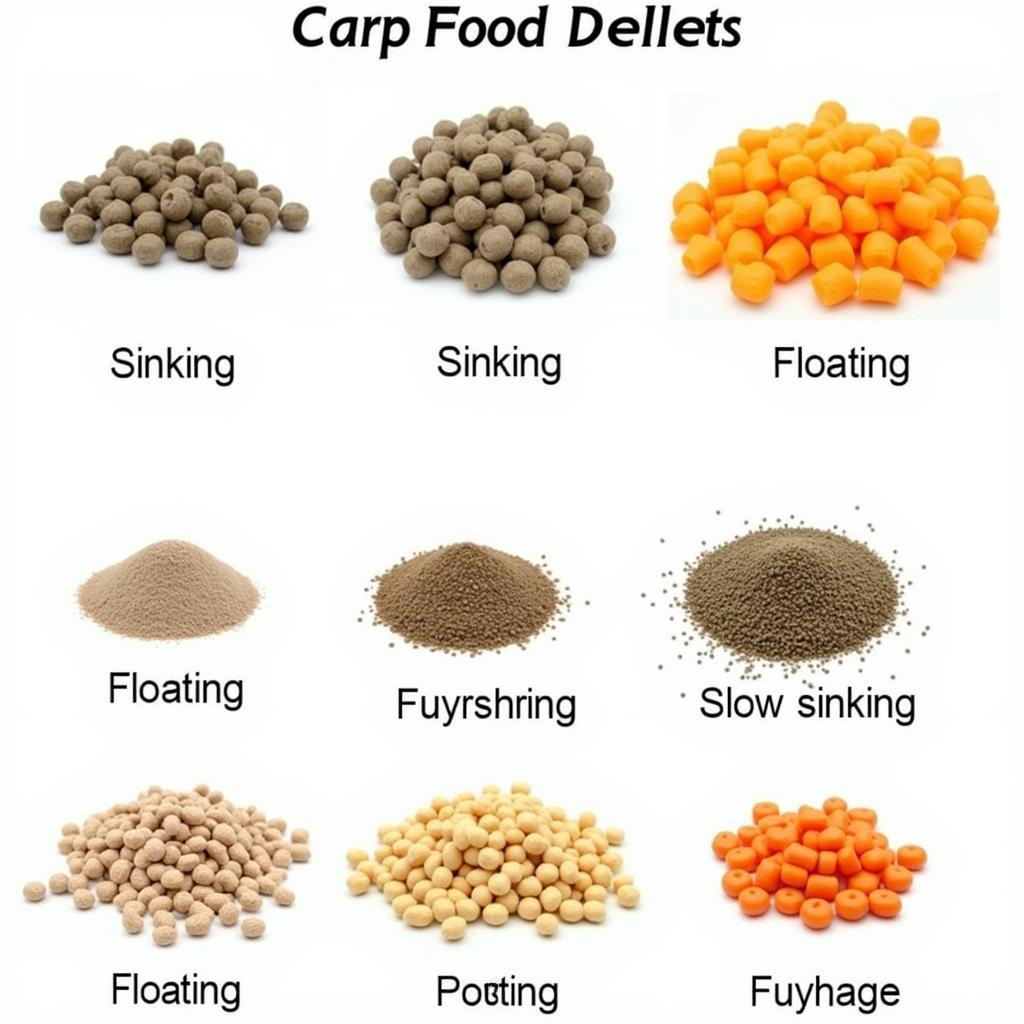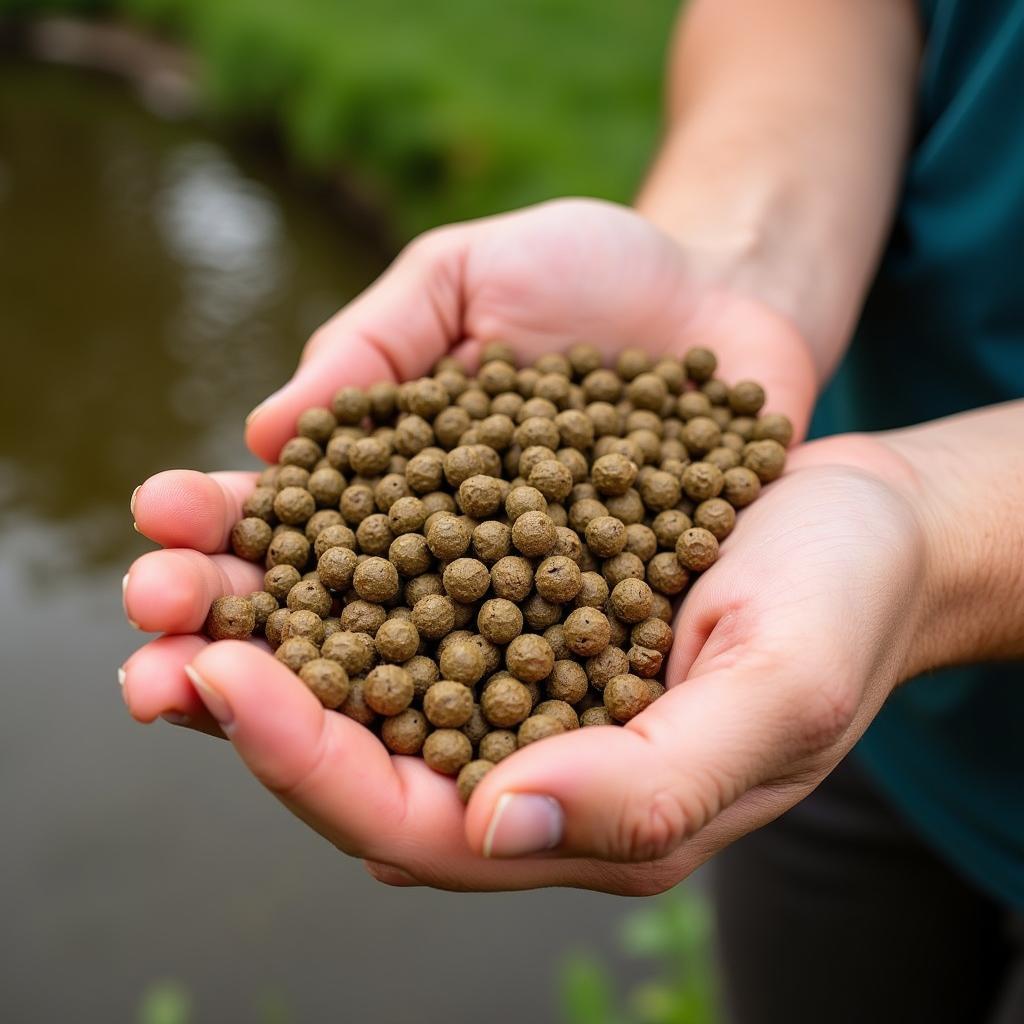Carp Food Pellets are a staple diet for many carp anglers and pond owners. Choosing the right pellet can significantly impact the health, growth, and vibrancy of your carp. This comprehensive guide delves into the world of carp pellets, exploring their various types, benefits, and how to choose the perfect one for your needs. After reading this, you’ll be equipped to make informed decisions about feeding your carp.
Understanding the Different Types of Carp Food Pellets
Carp food pellets come in a wide variety of formulations, each designed to meet specific needs. Understanding the differences is crucial for optimal carp care. Here’s a breakdown of the common types:
- Sinking Pellets: These are the most common type, designed to sink quickly to the bottom, ideal for bottom-feeding carp. They come in various sizes and protein levels.
- Floating Pellets: These pellets remain on the surface, encouraging carp to feed higher in the water column. They’re excellent for observing feeding habits and can be particularly useful in shallower ponds.
- Slow-Sinking Pellets: These offer a middle ground, sinking slowly and allowing carp at all levels to feed. They can be beneficial in ponds with varying depths.
- High-Protein Pellets: Packed with protein, these pellets are designed for growth and are often used in fish farms or for anglers looking to maximize carp size.
- Low-Protein Pellets: These are a good choice for maintaining healthy carp without promoting excessive growth. They can be particularly suitable for mature fish.
For those interested in the best options for koi carp, check out our guide on best koi carp food.
 Various Carp Food Pellets: Sinking, Floating, and Slow-Sinking
Various Carp Food Pellets: Sinking, Floating, and Slow-Sinking
Choosing the Right Carp Food Pellets: Factors to Consider
Selecting the best carp food pellets requires careful consideration of several factors. What works best for one pond might not be suitable for another. Let’s examine some key aspects:
- Water Temperature: Carp metabolism slows down in colder water, reducing their need for high-protein food. Choose pellets with adjusted protein levels according to the season.
- Carp Size and Age: Younger carp require higher protein levels for growth, while mature fish benefit from lower protein and higher fiber content.
- Pond Environment: The size and depth of your pond, as well as the presence of other fish species, can influence the ideal pellet type.
- Feeding Habits: Observe your carp’s feeding behavior to determine whether sinking, floating, or slow-sinking pellets are most appropriate.
Benefits of Using Carp Food Pellets
Carp food pellets offer numerous advantages over other food sources:
- Nutritional Balance: Formulated to provide a complete and balanced diet, ensuring optimal health and growth.
- Convenience: Easy to store, handle, and dispense, simplifying the feeding process.
- Water Quality: High-quality pellets are less likely to pollute the water compared to other food types, maintaining a healthier pond environment.
- Cost-Effective: Pellets offer a concentrated source of nutrients, providing value for money in the long run.
Need a larger supply? Check out our pond fish food 50 lb.
How to Feed Carp Pellets Effectively
Proper feeding techniques are essential to maximize the benefits of carp food pellets:
- Determine the Right Quantity: Start with a small amount and observe how much your carp consume within a few minutes. Adjust the quantity accordingly to avoid overfeeding.
- Establish a Feeding Schedule: Feed your carp at regular intervals, preferably once or twice a day, to promote healthy digestion.
- Distribute Pellets Evenly: Scatter the pellets across the pond surface or use a feeder to ensure even distribution and prevent competition.
- Monitor Water Quality: Regularly check the water parameters to ensure the pellets aren’t negatively impacting water quality.
Thinking about other fish in your pond? We have resources on fish food for pond fish. You can also find information tailored to specific species like our guide on fish food for bream.
 Holding Carp Food Pellets for Feeding
Holding Carp Food Pellets for Feeding
“Choosing the correct carp food pellets is vital for ensuring the overall health and vitality of your fish,” says Dr. Emily Carter, a leading aquatic veterinarian. “A balanced diet contributes significantly to disease resistance and vibrant coloration.”
Conclusion: Optimizing Carp Health with the Right Pellets
Choosing the appropriate carp food pellets is a fundamental aspect of responsible carp care. By understanding the different types, considering the specific needs of your carp and pond environment, and implementing effective feeding strategies, you can ensure that your carp thrive. Using high-quality carp food pellets is an investment in the long-term health and well-being of your fish, contributing to a vibrant and thriving aquatic ecosystem.
FAQ
- How often should I feed my carp pellets? Once or twice a day is usually sufficient.
- What size pellets are best for my carp? Pellet size should correspond to the size of your carp’s mouth.
- Can I mix different types of pellets? Yes, you can mix different types to provide variety and cater to different feeding habits.
- How do I store carp food pellets? Store in a cool, dry place to maintain freshness.
- What are the signs of overfeeding? Cloudy water, excessive algae growth, and uneaten pellets are signs of overfeeding.
- Are carp food pellets suitable for all carp species? Most carp species thrive on pellets, but it’s always best to choose a formula specifically designed for your type of carp.
- How can I transition my carp to a new pellet brand? Gradually introduce the new pellets over several days, mixing them with the old food.
For further assistance, contact us at Phone Number: 02437655121, Email: [email protected] Or visit us at: 3PGH+8R9, ĐT70A, thôn Trung, Bắc Từ Liêm, Hà Nội, Việt Nam. We have a 24/7 customer service team.